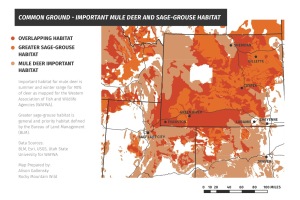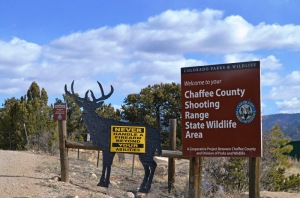Artemis and NWF release report highlighting link between mule deer and sage-grouse 
Just as mule-deer hunters are getting ready to head into the field for hunting season, members of the sportswomen’s group Artemis are releasing a report to raise awareness that anyone who cares about deer should care about greater sage-grouse and the remarkable effort across the West to save the iconic bird.
Artemis and the National Wildlife Federation, today released the report “Living on Common Ground – Sportswomen speak out to save the mule deer, sage-grouse and sagebrush country.”
Mule deer and sage-grouse have been in decline across much of the West. Sage-grouse used to number in the millions, but now less than a half million remain. A recent study in Pinedale, Wyo., found that mule deer herds have declined by 40 percent in the heavily developed gas fields of the region. The report explores what for sportswomen is impossible to ignore – sagebrush lands throughout the West provide vital habitat for both species and those lands are steadily disappearing. 
“Mule deer and sage-grouse are the canaries in the coal mine for sage steppe health,” says Jessi Johnson, Artemis coordinator and Wyoming Wildlife Federation public lands coordinator. “If we fail to listen to the warnings they are giving us with their dwindling numbers, we will lose not only two iconic Western species but a host of dependent flora and fauna and the very essence of what makes living in the West so special.”
Hearing that warning, a diverse group of stakeholders from across the West, including the sporting community, came together to build conservation plans aimed at saving sage-grouse. Completed in 2015, these sage-grouse conservation plans allowed the U.S. Fish and Wildlife Service to conclude that the bird didn’t need to be added to the endangered species list. The conservation plans instead represent a balanced approach to management of the bird’s habitat on our nation’s public lands that would also accommodate other careful uses.
However, changes being considered by the Trump administration could now derail implementation of the plans, threatening the fate of sage-grouse and the more than 350 species, including mule deer, which depend on the West’s sagebrush lands. Interior Secretary Zinke seeks to weaken safeguards meant to accommodate responsible development on sagebrush lands while preserving their value as habitat. Instead, the Secretary continues to drift away from conserving healthy habitats, continuing to explore instead unsound schemes relying on population numbers and captive breeding.
“Where will those captive-bred birds find homes,” asks Kate Zimmerman, the National Wildlife Federation’s public lands policy director. “The sage-grouse conservation plans are the result of long, hard work of stakeholders across the West who spent years finding common ground and a pathway to the future for both people and wildlife. It would be an ominous blow to sage-grouse and mule deer and all of us who live in the West if we can no longer safeguard the lands where they find food and cover.”
Artemis understands that hunters will be key to ensuring that both the species thrive into the future and is urging support for the sage-grouse conservation plans.
“As an avid hunter of mule deer on public land, I feel it’s of the utmost importance that their breeding and feeding grounds are maintained and protected,” says Artemis co-founder Cindi Baudhuin. “I hope that ‘Living on Common Ground’ will help drive home the important link between mule deer and sage-grouse for hunters.” 
Artemis and NWF continue to move forward by reaching out to hunters, local communities, and other wildlife advocates to ensure everyone understands that the future of mule deer and sage- grouse are inextricably linked.
“As hunters, anglers and wildlife conservationists, now is the opportunity to work to ensure these populations exist for future generations,” says Sara Domek, Artemis Co-founder. “Sustaining and enhancing seasonal movement corridors and stay-over habitat of wildlife need to be a priority, and the conservation plans provide tangible measures to protect mule deer and sage-grouse habitat.”
***
Artemis is a group of bold sportswomen creating fresh tracks for conservation and an initiative of NWF. Mule deer are a particular species of concern for Artemis. Follow Artemis on Facebook, Twitter and Instagram
The National Wildlife Federation is America’s largest conservation organization, uniting all Americans to ensure wildlife thrive in a rapidly changing world. Follow us on Facebook, Twitter, and Instagram.


